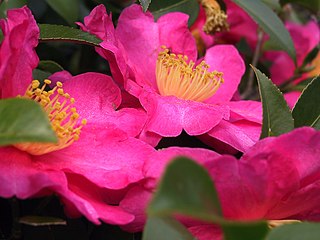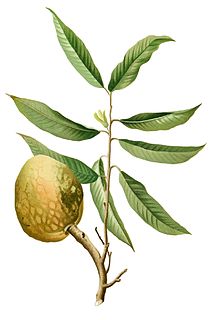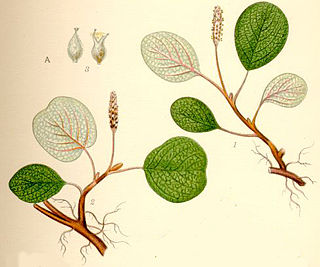
The substantia nigra (SN) is a basal ganglia structure located in the midbrain that plays an important role in reward and movement. Substantia nigra is Latin for "black substance", reflecting the fact that parts of the substantia nigra appear darker than neighboring areas due to high levels of neuromelanin in dopaminergic neurons. It was discovered in 1784 by Félix Vicq-d'Azyr, and Samuel Thomas von Sömmerring alluded to this structure in 1791. Parkinson's disease is characterized by the loss of dopaminergic neurons in the substantia nigra pars compacta.

Citrus is a genus of flowering trees and shrubs in the rue family, Rutaceae. Plants in the genus produce citrus fruits, including important crops such as oranges, lemons, grapefruits, pomelos, and limes.

Camellia is a genus of flowering plants in the family Theaceae. They are found in eastern and southern Asia, from the Himalayas east to Japan and Indonesia. There are 100–300 described species, with some controversy over the exact number. There are also around 3,000 hybrids. The genus was named by Linnaeus after the Jesuit botanist Georg Joseph Kamel, who worked in the Philippines and described a species of camellia. Camellias are famous throughout East Asia; they are known as cháhuā in Chinese, tsubaki (椿) in Japanese, dongbaek-kkot (동백꽃) in Korean, and as hoa trà or hoa chè in Vietnamese.

The mandarin orange, also known as the mandarin or mandarine, is a small citrus tree with fruit resembling other oranges, usually eaten plain or in fruit salads. Reddish-orange mandarin cultivars can be marketed as tangerines, but this is not a botanical classification.

Custard apple is a common name for a fruit, and the tree which bears it, Annona reticulata.

Annona reticulata is a small deciduous or semi-evergreen tree in the plant family Annonaceae. It is best known for its fruit, called custard apple, a common name it shares with fruits of several other species in the same genus: A. cherimola and A. squamosa or sometimes it is called wild-sweetsop, bull's heart, bullock's-heart, or ox-heart. The flavor of the fruit is sweet and pleasant, but less popular than that of A. cherimola.
The pars reticulata is a portion of the substantia nigra. Most of the neurons that project out of the pars reticulata are inhibitory GABAergic neurons.

The tangor is a citrus fruit hybrid of the mandarin orange and the sweet orange. The name "tangor" is a formation from the "tang" of tangerine and the "or" of "orange". Also called the temple orange, its thick rind is easy to peel and its bright orange pulp is sour-sweet and full-flavoured.

Salix reticulata, the net-leaved willow, or snow willow, is a dwarf willow, native to the colder parts of Europe, North America, and Northern Asia. It is found in the western United States, including the Sierra Nevada and Rocky Mountains. In Europe it extends south through the Carpathian Mountains and Alps to the Pyrenees and the mountains of Macedonia. It is common in Canada, Greenland and Finland, and present but rare in Scotland.

The blue-streaked lory is also known as the blue-necked lory. It is a medium-sized parrot (31 cm), which is found on the Tanimbar Islands and Babar in the southern Moluccas.

The cam sành or King orange is a citrus hybrid originating in Vietnam.

Syringa reticulata is a species of Lilac, native to eastern Asia: in northern Japan, northern China, Korea, and far southeastern Russia (Primorye).

The external globus pallidus (GPe) combines with the internal globus pallidus (GPi) to form the globus pallidus, an anatomical subset of the basal ganglia. Globus pallidus means "pale globe" in Latin, indicating its appearance. The external globus pallidus is the segment of the globus pallidus that is relatively further (lateral) from the midline of the brain.

The guppy, also known as millionfish and rainbow fish, is one of the world's most widely distributed tropical fish, and one of the most popular freshwater aquarium fish species. It is a member of the family Poeciliidae and, like almost all American members of the family, is live-bearing. Guppies, whose natural range is in northeast South America, were introduced to many habitats and are now found all over the world. They are highly adaptable and thrive in many different environmental and ecological conditions. Male guppies, which are smaller than females, have ornamental caudal and dorsal fins. Wild guppies generally feed on a variety of food sources, including benthic algae and aquatic insect larvae. Guppies are used as a model organism in the fields of ecology, evolution, and behavioural studies.

Celtis reticulata, with common names including netleaf hackberry, western hackberry, Douglas hackberry, netleaf sugar hackberry, palo blanco, and acibuche, is a small- to medium-sized deciduous tree native to western North America.

Agnorhiza reticulata, known by the common name El Dorado County mule's ears, is a rare species of flowering plant found only in a small region of north-central California.

The reticulated giraffe, also known as the Somali giraffe, is a subspecies of giraffe native to the Horn of Africa. It lives in Somalia, southern Ethiopia, and northern Kenya. There are approximately 8,500 individuals living in the wild. The reticulated giraffe was described and given its binomial name by British zoologist William Edward de Winton in 1899, however the IUCN currently recognizes only one species of giraffe with nine subspecies.
Hemilophini is a tribe of longhorn beetles of the Lamiinae subfamily.
The Nanfengmiju is a rare non-hybrid citrus.
Acasanga humeralis is a species of beetle in the family Cerambycidae. It was described by Waterhouse in 1880. It is known from Ecuador.

















